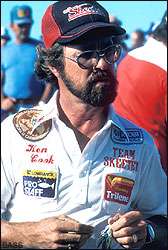
For years, people could easily pick out Ken Cook on the CITGO Bassmaster Tournament Trail presented by Busch Beer by his coke-bottle glasses.
Cook, a veteran bass pro from Meers, Okla., and winner of the 1991 CITGO Bassmaster Classic, grew up near-sighted. Today, the 56-year-old competitor can see better than he could as a child.
"When hunting, I realized that my friends could always see squirrels before I could," Cook remembered. "My parents finally took me to the eye doctor and I got glasses when I was 10. I remember first being able to see the gravel in the road instead of just the road and seeing squirrels before they moved."
Cook wore thick glasses until 2001. As with all glasses, his specs required constant cleaning, defogging and occasional replacing. He wasted precious fishing time cleaning glass instead of casting for bass.
"Glasses work all right, but they are a pain," Cook explained. "I couldn't buy sunglasses off the shelf or buy curved sunglasses that better protect my eyes. I had to use flat sunglasses or order custom wraparounds. When I got older, I had to have bifocals. When hunting, I had to move my head too much to see so I looked into laser surgery."
Dr. Gary Nesty of Solar Bat, where Cook ordered his custom sunglasses, recommended Dr. Nicholas R. Rader of the Indiana Eye Clinic. Cook visited Indiana and decided to undergo laser vision correction surgery, or Lasik, in the summer of 2001.
With this procedure, doctors measure eyes, almost like making a miniature ocular topographical map. They use lasers to reshape eyeballs. The reshaping allows light to hit in the proper place, almost like fine-tuning binoculars to achieve proper focus.
"The doctor attached an apparatus to my eyeballs that moved with my eyes," Cook said. "They propped my eyes open so I couldn't blink and kept them hydrated. There was a bit of heat sensation as I focused on the light. It's really a simple procedure that took about 20 minutes. I was awake the entire time. It didn't hurt, but there was a little discomfort when they propped my eyes open."
Before the procedure started, Doctor Rader asked Cook to tell him what time showed on a clock about 15 feet away. Without his glasses, Cook could not do it. After the surgery, the doctor asked the same question. Elated, Cook could not only see the clock, but the hands on the clock.
"I could never see that well since I was born," Cook said. "In the next 24 hours, it was uncomfortable. I had to put something in my eyes to lessen the discomfort. For the next three or four days, my eyes felt irritated like I had something in them. My vision kept improving for about six months until all the scar tissue healed. Now, my right eye has 20/15 vision. My left eye is slightly far-sighted, but it's close enough to drive. For me, it was worth it. Being able to walk though the woods and see without foggy lenses is a miracle."
The improved vision now helps Cook see fish in the water better. He doesn't need glasses to drive his truck or boat, but does still use reading glasses for tying knots. He bought stick-on enhancements to serve as miniature bifocals for close work. He attaches these to his sunglasses when fishing and can swap them from lens to lens.
Intense light or strong glare sometimes causes him discomfort, Cook said. Sudden bright lights hitting his face at night, when his eyes dilate to compensate for the limited light, bother him a bit.
To shield his eyes from bright light, Cook still uses Solar Bat sunglasses, but no longer orders custom pairs. He uses lenses with different colors to compensate for prevailing conditions. Amber lenses provide the most versatile vision enhancement.
"Color helps to accentuate what anglers can see in the water," Cook said. "I like to use a contrasting color to bring out objects. Yellow brightens things up. Amber makes the green of bass pop out so I can see them better. In brown water, green tends to make objects stand out. In clear or green water, I wear amber. On an overcast day, I use amber or yellow. On a rainy day, I use yellow. On a bright, high-pressure day, I wear green."
